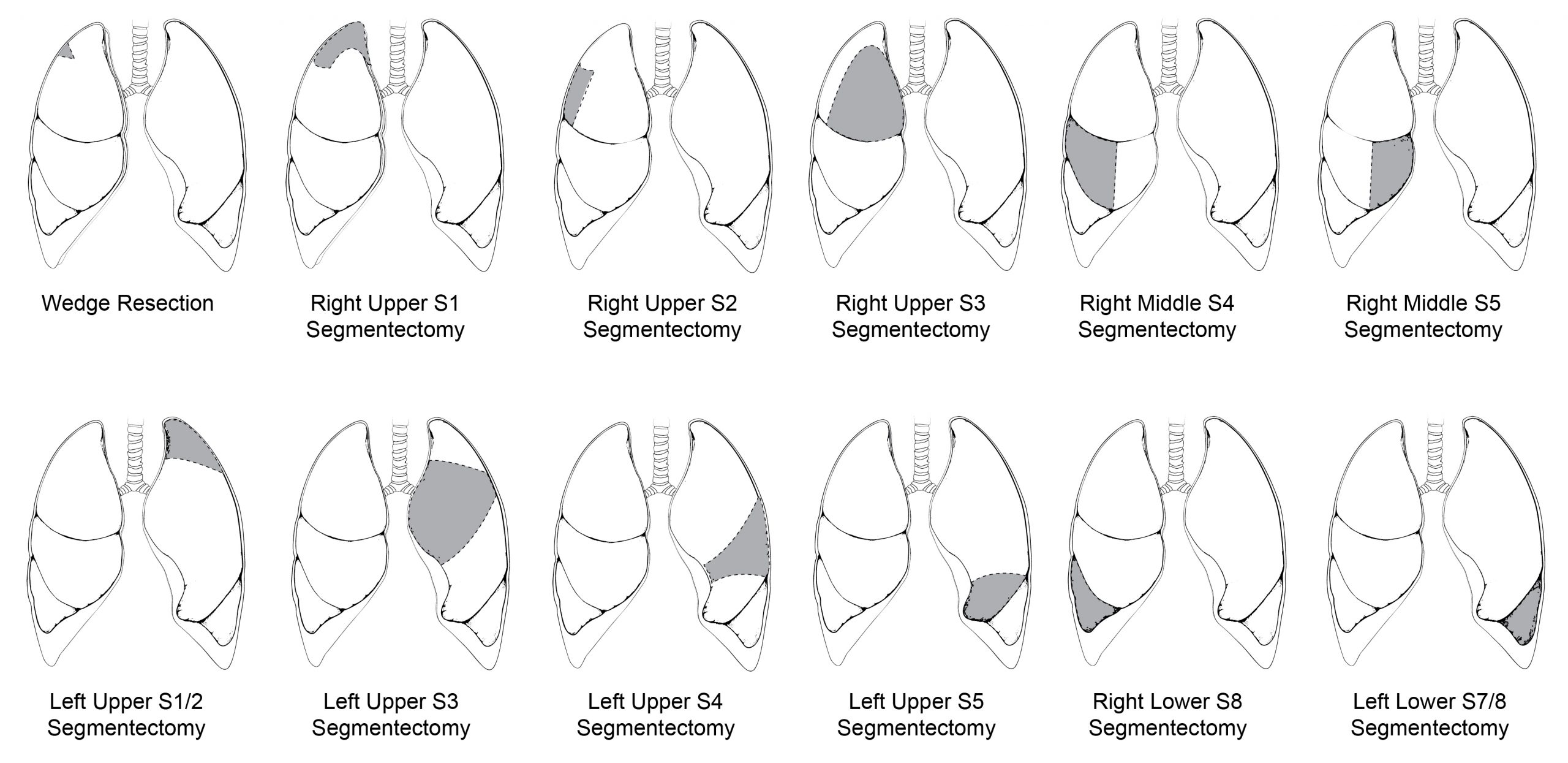What is pulmonary segmentectomy?
Pulmonary segmentectomy is a type of surgery used to treat lung cancer by removing a segment (or segments) of the lung. This procedure is considered a less invasive alternative to a full lobectomy, which involves removing an entire lobe of the lung. Imagine a tree branch where the smaller branches are taken instead of the entire trunk. By removing only the affected segment, the healthy lung tissue can be preserved, leading to better lung function after surgery. In addition, sparing the lung means you have more options later in life if you are diagnosed with a second lung cancer or other disease of the lung.

Reasons for pulmonary segmentectomy
Pulmonary segmentectomy is typically recommended for patients with early-stage lung cancer, where the tumor is small and confined to a single segment of the lung. It may also be considered for patients with limited lung function who may not tolerate a lobectomy. When patients are enrolled into a lung cancer screening program, they have a higher chance of having early lung cancer diagnosed. The earlier the cancer is diagnosed, the better the survival of the patient.
Your doctor may consider several factors when deciding if a segmentectomy is right for you, including tumor size, location and overall lung function. Segmentectomy is generally recommended for tumors that are smaller than 2 centimeters and located in a peripheral area of the lung. Patients with limited lung function or other comorbidities that may make a lobectomy risky may also be considered for segmentectomy.
Benefits of pulmonary segmentectomy
– Preserving lung function: By removing only the affected segment, the overall lung function can be better preserved compared to a lobectomy, where a larger portion of the lung is removed.
– Minimally invasive: Pulmonary segmentectomy can be performed using minimally invasive techniques, such as video-assisted thoracoscopic surgery (VATS) or robotic-assisted surgery (RATS), which involves smaller incisions, less blood loss, less pain and potentially a faster recovery time. Both minimally invasive techniques are offered at Baylor Medicine.
– Lower risk of complications: With a smaller extent of lung resection, there is a reduced risk of post-operative complications such as air leaks or respiratory failure. This can translate into you being discharged from the hospital sooner and getting home quicker.
Outcomes and prognosis
The overall prognosis for patients undergoing pulmonary segmentectomy for lung cancer is generally favorable, especially in early-stage disease. Studies have shown comparable survival rates between segmentectomy and lobectomy for tumors less than 2 centimeters in size.
Surgery and recovery
Pulmonary segmentectomy can be performed using different surgical approaches, including open thoracotomy or minimally invasive techniques such as video-assisted thoracic surgery or robotic-assisted surgery. VATS involves making small incisions and using a thoracoscope and specialized instruments to remove the segment. Robotic-assisted surgery utilizes a robotic system controlled by the surgeon to perform the procedure with enhanced precision.
During pulmonary segmentectomy, the surgeon also may perform lymph node evaluation to determine if the cancer has spread to nearby lymph nodes. This is important for accurate staging and treatment planning. Lymph node evaluation can be done through mediastinal lymph node dissection or sampling, depending on the patient’s condition.
Following pulmonary segmentectomy, patients typically stay in the hospital for a few days to monitor their recovery. Pain management, breathing exercises and early mobilization are important components of postoperative care. The recovery period may vary depending on the patient’s overall health and the extent of the surgery, but most patients can expect to return to their normal activities within a few weeks.
In some cases, adjuvant therapy, such as chemotherapy or radiation therapy, may be recommended after pulmonary segmentectomy. Adjuvant therapy aims to target any remaining cancer cells that may not have been removed during surgery and reduce the risk of recurrence. These tumor cells might be circulating in the blood stream or microscopically traveling to the lymph nodes and remain undetected. The decision to pursue adjuvant therapy is based on several factors, including the stage of the cancer and the individual patient’s overall health. Determining the stage of the cancer also allows the team to determine the likelihood of cancer being present in the body in such undetected ways.
Surgical techniques
Pulmonary segmentectomy can be performed using different techniques, depending on the specific case and surgeon’s preference. Two commonly used techniques are wedge resection and anatomic segmentectomy. Wedge resection involves removing a small portion of the lung containing the tumor, while anatomic segmentectomy involves removing the entire segment of the lung where the tumor is located.
Non-anatomic segmentectomy is not technically considered a true segmentectomy. For the thoracic surgeon to do a correct segmentectomy, the blood vessels heading to that segment are individually identified, stapled and divided. The airway passage heading to that segment, called the bronchus, is also individually divided, often with a stapler as well. The lymph nodes surrounding those structures and around the lung are systematically removed and sent for analysis as well. Each of these steps are taken to deliver what is called an anatomic resection. Studies show that removal of the lymph nodes and the segment following guidelines can give the patient more information about the stage of their cancer and potentially allow a more accurate evaluation that can lead to more patients having access to post-surgery (called adjuvant) therapy. In some cases, getting the right type of therapy after surgery and having better staging information can lead to improved survival.
Anatomic segmentectomy is a technique where the surgeon removes the entire anatomical segment along with its associated bronchus, artery and vein. This ensures complete removal of the cancerous tissue while preserving the surrounding healthy lung tissue.

Long-term outcomes
Studies show favorable, long-term outcomes for patients undergoing pulmonary segmentectomy for early-stage lung cancer. The overall survival rates for segmentectomy are comparable to lobectomy for tumors smaller than 2 centimeters, suggesting that segmentectomy can be an effective treatment option for selected patients. Regular follow-up with a healthcare provider is essential to monitor for any recurrence or new developments.
Risk of recurrence
While segmentectomy is an effective treatment option for early-stage lung cancer, there is a slightly higher risk of local recurrence compared to lobectomy when the tumor is greater than 2 centimeters. This is because segmentectomy may not remove all potentially cancerous cells in the surrounding lung tissue if the tumor is large than the segment. Sometimes the tumor might be between segments or at the edge of a segment or at the surface of the lung, and in these cases, a segmentectomy may not be ideal. However, regular follow-up and surveillance can help detect any recurrence early and guide further treatment if necessary.
By Dr. Shanda Blackmon, director of The Lung Institute at Baylor Medicine and senior faculty in the David J. Sugarbaker Division of Thoracic Surgery



